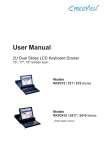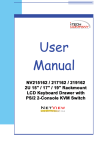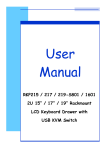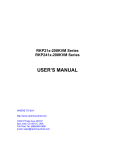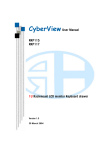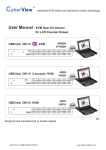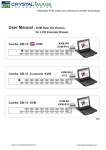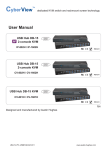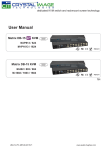Download CyberView RKP215-1601 User manual
Transcript
CyberView User Manual RKP215-801 RKP217-801 RKP215-1601 RKP217-1601 2U Rackmount LCD monitor Keyboard drawer with KVM switch Version 2.0 20 March 2004 User Manual Table of Contents 1.0 General............................................................................................................ 3 1.1 Unit Introduction........................................................................................... 3 1.2 Unit Photograph............................................................................................ 3 1.3 Unit Features ................................................................................................ 3 1.4 Unit Packing Contents ................................................................................... 3 1.5 Important Information & Safeguards ............................................................... 4 1.6 Preparation for Use....................................................................................... 4 2. LCD On Screen Display ......................................................................................... 5 2.1 Display & Navigation Using Membrane Keys ................................................... 5 2.2 Customizing the LCD Settings......................................................................... 6 3. Miscellaneous Sub Menu ..................................................................................... 7 4. Setting OS Refresh Rate - Microsoft Windows® ..................................................... 9 5. Connecting Your KVM Switch.............................................................................. 10 6. Cascading KVM Switches ................................................................................... 10 7. KVM Navigation Using Membrane Keys ............................................................... 11 8. KVM Navigation using On Screen Display & Hot keys ........................................... 12 8.1 OSD Password ............................................................................................ 12 8.2 Consol ON / OFF .......................................................................................... 12 8.3 To reset the KVM to default setting using the membrane keys ........................ 13 8.4 To select the previous channel .................................................................... 13 8.5 To select the next channel........................................................................... 13 8.6 To select the previous bank......................................................................... 13 8.7 To select a specific bank and channel ......................................................... 13 8.8 To Turn channel beeper on or off ................................................................. 13 8.9 To Auto scan channels ................................................................................ 13 8.10 To reset the KVM to default ROM setting....................................................... 14 8.11 To identify an active channel....................................................................... 14 8.12 To assign a channel a name designation ...................................................... 14 8.13 To find a channel by its name designation .................................................... 14 9. LCD Technical Specification ............................................................................... 15 10. KVM Technical Specification .......................................................................... 17 11. LCD Troubleshooting....................................................................................... 18 11.1 The LCD does not function, the PC input is operational .................................. 18 11.2 The message ‘Check Cable’ appears on the LCD............................................ 18 11.3 The message ‘No Sync’ appears on the LCD .................................................. 18 11.4 The message ‘Signal out of Range’ appears on the LCD ................................. 18 12. KVM Troubleshooting...................................................................................... 18 12.1 The Keyboard does not work after boot up .................................................... 18 12.2 The Mouse is not detected during PC boot routine......................................... 18 13. Warranty........................................................................................................ 19 13.1 Period & Conditions .................................................................................... 19 13.2 Manufacturers exclusions............................................................................ 19 14. Disclaimer ..................................................................................................... 19 www.austin-hughes.co.uk Page 2 User Manual 1.0 1.1 General Unit Introduction Thank you for purchasing the 2U Rackmount LCD monitor keyboard drawer with KVM switch. The unit is a unique combined 19” rack mountable unit designed to provide access to and control of multiple servers from a single unit. The unit offers space saving leading edge, flexible, features and provide tangible benefits to the user while ensuring the reliability, cost efficiency and return on hardware investment expected for today’s broadcast, enterprise and service provider networks. 1.2 Unit Photograph 1.3 Unit Features • • • • • • • • • 1.4 15 or 17 inch TFT/LC active matrix color Built in OSD (On Screen Display) controlled by integral membrane keys Flexible keyboard selections, notebook type with touch pad mouse or Cherry type with trackball mouse, available in multiple languages Keyboard slide rails have friction stop positions to prevent accidental movement Built in 8 or 16 port KVM switch, cascade-able to 64 / 128 ports or servers Unique KVM integral membrane one button port selection KVM port selection through OSD Hot key menus Efficient cable management, the unit is supplied with 8 x 6ft screened VGA cables with combined PS2 mouse and keyboard connectors – refer to section 5.0 of this user manual Single external 12V 5A remote power adaptor, easy to replace and ensures only a single power source is required to the unit , reducing the capacity of UPS outputs for KVM switches required Unit Packing Contents Model Number 801 1601 RKP215 / 217 2U LCD Keyboard Drawer with KVM Unit 1 1 User Manual CD 1 1 Quick Reference Guide 1 1 AC to DC Power Adaptor 1 1 Standard 6ft 3 in 1 KVM cables (CD-6) 8 8 Rack Mount Kit 1 1 www.austin-hughes.co.uk Page 3 User Manual 1.5 • • • • • • • • • • • • 1.6 • • • • • • • • • Important Information & Safeguards Please read these safety instructions carefully Keep this user manual for later reference Disconnect the unit from the mains input power supply source before cleaning Do not spray aerosol or liquid cleaners directly on the unit, use only a soft cloth for cleaning Clean the LCD only with a soft anti static cloth Avoid placing pressure on the LCD to prevent permanent damage Rest the unit on a reliable surface when installing, a drop or fall may cause injury Please note all cautions and warnings on the equipment Never open the unit. Only qualified personnel should open the unit Refer to section 10.0 of this user manual regarding recommended storage and operating conditions for the unit Refer to sections 11.0 and 12.0 of this user manual regarding troubleshooting of the unit Refer to section 13.2 of this user manual regarding improper use of the unit Preparation for Use Carefully remove the unit from its packaging Please check that the unit and its accessories match the packing contents in section 1.4 of this user manual Please read this user manual thoroughly familiarising yourself with the unit Place the unit on a protected work surface and carefully slide open the keyboard drawer noting the friction stops on the slides to prevent movement of the keyboard whilst in use Carefully slide open and lift the LCD screen to a convenient viewing angle Plug up the DC power supply, whilst noting that the green LED on the external adaptor should now be lit You should now be able to see the LED lights on the unit functioning you could also follow section 2.0 to familiarise yourself with the OSD (On screen display) of the unit After removing the DC power input, carefully install the unit into the rack, noting section 1.5 of this user manual - important information and safe guards, and plug in all connecting hardware (ensure all connecting hardware is powered down for this stage of the install) Further information regarding the use of this unit can be found in the following sections of this user manual www.austin-hughes.co.uk Page 4 User Manual 2. LCD On Screen Display 2.1 Display & Navigation Using Membrane Keys The On screen display built into the unit provides users with an efficient method of adjusting to the display input signal. This section explains clearly how to navigate the OSD using the membrane keys, shown below, that you will find on the unit to the right side of the LCD screen. 2.1.1 Exit Menu or sub menu Display OSD or scroll / select Input Value + or up / left scroll Input Value – or down / right scroll LCD Display On / Off To display the OSD Simply press the key marked www.austin-hughes.co.uk Page 5 User Manual 2.1.2 To Select a Menu Item Simply press the key to scroll 2.1.3 To Enter the Sub Menu Simply press the key marked 2.1.4 To Change an Input Value Simply use the key marked 2.1.5 To Save the setting Simply press the key marked 2.1.6 To Exit the Main Menu Simply use the key marked 2.2 2.2.1 Customizing the LCD Settings Brightness / Contrast To adjust brightness - follow steps 2.1.1 through 2.1.5 2.2.2 Auto Adjust To auto adjust - follow steps 2.1.1 through 2.1.5 NOTE -: While the OSD Menu is NOT displayed the www.austin-hughes.co.uk key acts as Auto Adjust Page 6 User Manual 2.2.3 Phase / Clock To optimize display qualities - follow the steps 2.1.1 through 2.1.5 2.2.4 Horizontal Screen Position To adjust horizontal screen position - follow the steps 2.1.1 through 2.1.5 2.2.5 Vertical Screen Position To adjust horizontal screen position - follow the steps 2.1.1 through 2.1.5 2.2.6 To reset to default factory setting To reset - follow the steps 2.1.1 through 2.1.5 3. Miscellaneous Sub Menu To select miscellaneous sub menu - follow the steps 2.1.1 through 2.1.5 www.austin-hughes.co.uk Page 7 User Manual 3.1.1 Information To select information sub menu - follow the steps 2.1.1 through 2.1.5 3.1.2 OSD Timeout To select OSD Timeout sub menu - follow the steps 2.1.1 through 2.1.5 3.1.3 Color To select Color sub menu - follow the steps 2.1.1 through 2.1.5 www.austin-hughes.co.uk Page 8 User Manual 3.1.4 OSD language To select the OSD language sub menu - follow the steps 2.1.1 through 2.1.5 4. Setting OS Refresh Rate - Microsoft Windows® On the windows desktop ‘right click’ the mouse key and then select ‘properties’ Select ‘Settings’ from the tab menu Select ‘Monitor’ and then select a Screen refresh Rate of 75 Hertz – Press OK to save and exit www.austin-hughes.co.uk Page 9 User Manual 5. Connecting Your KVM Switch 12V DC Power In KVM Channel Ports Cascade Port Consol Port • • • KVM Channel Port – to connect servers using 3 in 1 KVM cable Cascade Port – to connect to another KVM switch Consol Port – to be connected to previous bank (if exists) Cascade port 6. Cascading KVM Switches Using 3 in 1 KVM cable connect from Bank 1’s “Cascade port” to Bank 2’s “Console port”. When connected please press “Bank” & “Channel” button on the front of the KVM switch to reset the KVM Bank 1 Bank 2 A maximum of 8 banks or 128 ports can be cascaded. Austin Hughes ranges of KVM switches are fully compatible with most vendors KVM switches. www.austin-hughes.co.uk Page 10 User Manual Note – the maximum recommended distance between the KVM port and the server is 15ft, use Austin Hughes standard 3 in 1 KVM cable part number CD15 shown below. To cascade between switches use Austin Hughes standard cable CA15 the CA 15 cable has 2 x PS2 connections at both the ends of the cable. 7. KVM Navigation Using Membrane Keys Membrane Keys built into the unit provide users an efficient method of changing KVM ports very quickly and accurately. This section explains clearly how to switch and monitor the KVM ports using the membrane keys that you will find on the CyberView unit underneath the LCD screen. RED LED highlights ‘Active Channel’ RED & GREEN LED highlights ‘Active and On Line Channel’ Simply press this key to select a channel or port between 1-8 Simply press and hold together with a channel button to select ports 9-16 www.austin-hughes.co.uk Page 11 User Manual This LED box displays the Bank Select Bank Button 1 - 8 8. KVM Navigation using On Screen Display & Hot keys Hold down the FN key and press Scroll on your keyboard twice in succession - the OSD will be displayed for 10 Sec; this can be prolonged to 99 Sec 8.1 OSD Password Hold down the FN key and press Scroll on your keyboard twice in succession – the OSD will be displayed for 10 Sec; this can be prolonged to 99 Sec Select Change Password – the screen capture below will appear Key in the unit default password 00000000 Enter the new password (8 digits max) Re-Enter the new password Dialog will now display – Changing Password Complete 8.2 Consol ON / OFF If the Consol displays ON – any user can operate the unit If the Consul displays OFF – the user must key in the current password to operate the unit www.austin-hughes.co.uk Page 12 User Manual The Unit default setting is Consul OFF – the user must key in the current password to operate the unit 8.3 To reset the KVM to default setting using the membrane keys Simply press the 8.4 and channel buttons together To select the previous channel Simply press the Scroll on your keyboard twice in succession followed by the 8.5 on your keyboard To select the next channel Simply press the Scroll on your keyboard twice in succession followed by the on your keyboard Note – You may hold either arrow key to scan through channels 8.6 To select the previous bank Simply press the Scroll on your keyboard twice in succession followed by the PgUp on your keyboard 8.7 To select a specific bank and channel Simply press the Scroll on your keyboard twice in succession followed by the bank number and channel number on your keyboard Example Scroll + Scroll + bank number (1-8 Max.) + channel number (01-16 Max.) 8.8 To Turn channel beeper on or off Simply press the Scroll on your keyboard twice in succession followed by the B on your keyboard (default is beeper on) 8.9 To Auto scan channels Simply press the Scroll on your keyboard twice in succession followed by the S on your keyboard (default scan time is 10 Secs. from channel to channel) – Press any key on your keyboard to stop scanning www.austin-hughes.co.uk Page 13 User Manual 8.10 To reset the KVM to default ROM setting Simply press the Scroll on your keyboard twice in succession followed by the R on your keyboard (note -: THIS DOES NOT RESET THE PASSWORD) 8.11 To identify an active channel Simply look for the ☼ symbol on the on screen display next to the channel designation 8.12 To assign a channel a name designation Simply select the KVM OSD, see section 8.0 of this user manual, use the Tab key on your keyboard to select the default channel designation (e.g. SYSTEM 01) and press the INS key on your keyboard to edit the channel name designation, press ENTER on your keyboard when complete Note -: the channel name designation should not exceed 8 characters 8.13 To find a channel by its name designation Simply press the Scroll on your keyboard twice in succession followed by the F on your keyboard, type the channel name, see section *** of this user manual, press enter on your keyboard – the unit will begin searching from channel 1 www.austin-hughes.co.uk Page 14 User Manual 9. LCD Technical Specification LCD Video Size 15" Screen Area TFT Active Matrix Display Area 304.1mm (h) x 228.1mm (V) Contrast Ratio 300:1 Viewing Angle 130 deg (H) z 115 deg (V) TYP Resolution 1024 x 768 XGA Pixel Pitch 0.297mm (H) x 0.297mm (W) Response Time Tr = 5ms, TF = 20ms TYP Brightness 250 cd/m2 Panel Color 16.2M Colors Back Light 4 Lamps Synchronization Horizontal 48.36-60 KHz Range Vertical 56-75 Hz Input Signal Analog RGB 0.7Vp-p Power Management www.austin-hughes.co.uk VESA DPMS Power Micro on/off switch OSD Control Brightness, Contrast, Color, H Position, V Position, Auto Config, OSD Adjust, Dither, etc Power Input 12V/5A DC Adaptor Video Input 15-Pin D-sub connector Page 15 User Manual LCD Video Size 17" Screen Area TFT Active Matrix Display Area 337:92mm (h) x 270.336mm (V) Contrast Ratio 350:1 Viewing Angle 150 deg (H) z 125 deg (V) TYP Resolution 1280 x 1024 SXGA Pixel Pitch 0.264mm (H) x 0.264mm (W) Response Time Tr = 5ms, TF = 20ms TYP Brightness 250 cd/m2 Panel Color 16.7M Colors Back Light 4 Lamps Synchronization Horizontal 31-69 KHz Range Vertical 56-75 Hz Input Signal Analog RGB 0.7Vp-p Power Management VESA DPMS Power Micro on/off switch OSD Control Brightness, Contrast, Color, H Position, V Position, Auto Config, OSD Adjust, Dither, etc Power Input 12V/5A DC Adaptor Video Input 15-Pin D-sub connector www.austin-hughes.co.uk Page 16 User Manual 10. KVM Technical Specification PC Port 8 or 16 PC Port Connector (female) HDDB 15Pin Cascade Port (female) PS/2 Keyboard mini DIN 6 Pin PS/2 Mouse mini DIN 6 Pin VGA HDDB 15Pin PC Selection OSD Manual Control, Manual soft key Control & Hot Key Control 7 Segment LCD One Blank, Two PC Port LCD OSD Control Yes Scan Intervals 5-99 secs Keyboard Emulation PS2 Mouse Emulation PS2 VGA Resolution 1920 x 1440 Bandwidth 200 MHz Cascade 8 levels Maximum number of Ports 128 Housing material Coated Steel Power Adaptor DC 12V 1 A or DC 9V 1A Operating Temperature 0 - 40 deg Storage Temperature -20 / + 40 deg Humidity 0 - 80 deg Non Condensing Size 2U (44.5mm) (H) x 19" (W) Rack Mount www.austin-hughes.co.uk Page 17 User Manual 11. LCD Troubleshooting 11.1 The LCD does not function, the PC input is operational • Ensure that the Power adaptor is securely plugged in at both ends and has power feed from the supply source; check that the Green led light is on on the adaptor unit • Ensure the LCD is on by pressing the key • Ensure that the LCD is pulled out past the micro switch threshold 11.2 • The VGA cable input cable is not connected properly 11.3 • 12. The message ‘Signal out of Range’ appears on the LCD This message indicates that the input signal is beyond the LCD capability – The maximum resolution for the screen is 1024 x 768 at 75 Hz Check PC and Operating System output refer to step 4.0 KVM Troubleshooting 12.1 • The message ‘No Sync’ appears on the LCD The message indicates that there is no input signals from the PC, make sure the PC is functioning and that the graphics card is installed correctly. 11.4 • The message ‘Check Cable’ appears on the LCD The Keyboard does not work after boot up Ensure the PC output is OK by plugging a keyboard (101,102 or 104) directly into the PC port and testing 12.2 The Mouse is not detected during PC boot routine • Ensure the PC output is OK by plugging a PS2 mouse directly into the PC port and testing • Avoid moving the mouse whilst switching between KVM ports • Avoid switching ports whilst shutting down the PC • It is not recommended to reduce the scan time setting of the KVM switch to below 5 seconds – this may have an adverse effect on the switch recognizing the mouse connection. www.austin-hughes.co.uk Page 18 User Manual 13. Warranty 13.1 Period & Conditions Warranty is from the date of sale of the unit, subject to the terms and conditions of the Austin Hughes Europe Authorised channel partner who supplied the unit, please refer to your authorised channel partner for terms & conditions 13.2 Manufacturers exclusions 13.2.1 Any Unit on which the Austin Hughes serial number has been defaced, modified or removed 13.2.2 Damage, deterioration, or malfunction resulting from – accident, misuse, neglect, fire, water, lightening, or other acts of nature 13.2.3 Unauthorised unit modification 13.2.4 Unauthorised unit repair, by other than an Austin Hughes Europe authorised channel partner 13.2.5 Damage to the unit caused by installation or removal, unless covered by Austin Hughes Europe channel partner services warranty 14. 13.2.6 Use of unauthorised parts not meeting Austin Hughes Europe specifications 13.2.7 Other causes of damage unrelated to product defect including wear and tear 13.2.8 Damage to the unit caused by transit Disclaimer This information is subject to change without notice. Austin Hughes Europe accept no responsibility for damage or claims, resulting from misuse or misinterpretation of this information www.austin-hughes.co.uk Page 19



















